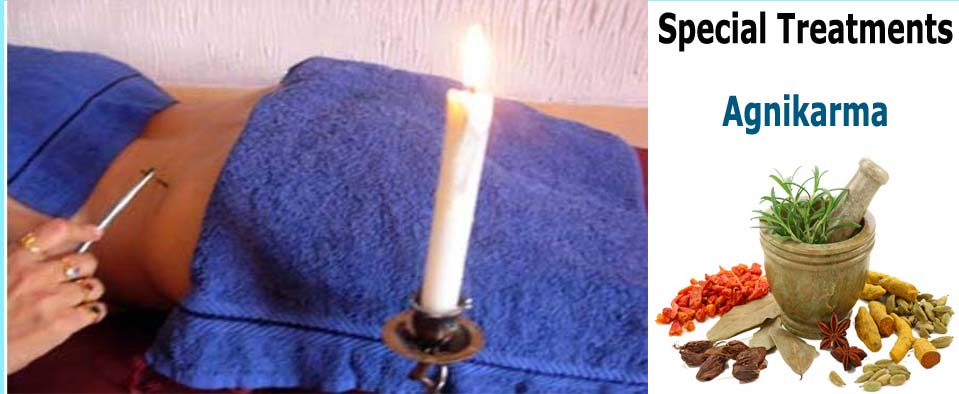

Pizhichil
In diseases connected with Vatham the principles of “Snehana” and “Swedana” are adhered to by Ayurveda. “Snehana” means applying fats (sesame oils, ghee etc.) either externally or internally and “Swedana” means sweating. There are several methods of doing either. Of these, in the case of Snehana, the most effective and convenient method of external applications is Pizhichil. What differentiates this from the sarvanga Dhara done with oily liquids is that it includes gentle massaging also.
This is done only on the body below the neck. The patient is made to lie on the Dhara Pathi (Drony). The attendants sit on either side, holding in their left hand linen dipped in comfortably warm oil medicated in occordance with the nature of each particular disease. They press enough oil from the linen to the patient’s body and then slowly massage the patient with the right hand. The process takes from one to one-and-a-half hours.
This is found very effective not only in diseases connected with Vatham; but also in many other diseases such as Diabetes, Blood pressure etc. It is doubtful if any other treatment is so fruitful in restoring strength and flesh of weak and lean persons, in a short time. Its effect is case of Asthma is immediate. In the early stages of Tuberculosis also its effects are really miraculous.
Navarakizhi
Navarakizhi is mainly used in diseases where Pizhichil also is indicated. But while the purpose of Pizhichil is Snehana, that of Navarakizhi is Swedana. Yet Navarakizhi is something more than mere Swedana. Here sweating is done by massaging with Kizhi (small linen bags) containing anti-vatha cereals boiled in cow’s milk mixed with Kashaya made up of anti-vata-flesh-giving medicines. Hence like Pizhichil this also is flesh-giving. Further, this is found generally effective in all cases where Pizhichil has proved inadequate. The patient is made to lie in Dhara Pathi; he is then smeared all over with oil medicated according to the needs of the disease; and two persons sitting on each side of the Dhara Pathil, massage the patient with the Kizhi prepared as above. The massage has to be continued for one to one-and-a-half hours.
At certain stages in rheumatic complaints this is done even without Pizhichil. But in severe cases it may be necessary to resort to this after Pizhichil, or do both simultaneously.
Generally Navara rice is the grain used for this purpose. But according to the difference in the degree of complaints other cereals like black-gram and meat cut in small pieces may be used instead and meat Kashaya etc. also may be added on to the liquid in which these are boiled.
Shirobasthi
Besides the above special treatments there is another treatment called Shirobasthi which is very important and very much in vogue. The treatment consists in keeping oily matter at easily bearable temperature, on the head. The object of this as of Sneha Dhara and Pizhichil is also Snehana. It is done by first fitting a leather cap on the head and pouring the oil into the cap. It is highly efficacious in the cases of Vatha affecting the head. Its effects are marvellous in Neuralgia, Hermicrania, Optic atrophy, Otalgia, Deafness, Facial Paralysis and in all diseases affecting cranial nerves. This will take from one to 1 ½ hrs. Generally it is not done for more than seven days at a time. The medicines used are Ksheerabala and Dhanawantharam oils medicated, Karpasasthyadi, Vathasani etc.
Sirolepa
200 or 250 grams of dried pulp of Amalaka, without the seeds, are boiled with half a litre of pure buttermilk mixed with an equal quantity of pure water. When the liquid is almost evaporated, the boiled pulp is taken from vessel and is ground into a fine paste, without adding any water or liquid. Some physicians, soak the Amalaka pulp in pure buttermilk in the previous night and grind the same into fine pulp in the next morning. Both ways are prevalent and satisfactory. The process can be done with out a Droni. The prescribed oil is applied on the head and body and a piece of cloth is tied around the head above the eye-brows as for the other treatments. Then the Amalaka paste is applied profusely all over the head except the forehead and face on a uniform thickness. Then the head is covered with a plantain leaf faded over a gentle fire, or by a lotus leaf tied round the head conveniently. After one or one and a half hours the covering and paste is removed and the head is wiped with dry cloth and the oil is applied again. Then the bath etc. shall be as for the Dhara treatment.
It will be better to have the head cleanly shaven or at least have the hair closely cropped, for both the Sirodhara and Sirolepa.
Period: The treatments are continued for 7, 14, 21, 28, 41 and 90 days – in very rare cases more too-according to the type and condition of the disease. But the usual period is 14 or 21 days.







